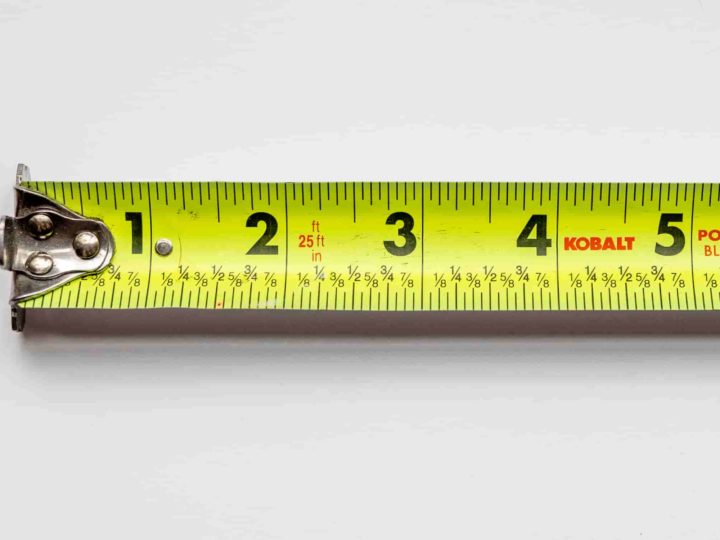Reading a measuring tape is a skill every DIYer needs to learn, but it doesn’t necessarily come naturally. I’ve owned many tape measures over the years and learned the hard way – through trial and error. To save you both time and money, I’ll be sharing how to read a measuring tape and what all those markings mean.
Table of Contents
- How To Read A Tape Measure
- Metric Vs Imperial
- Parts of a Tape Measure
- Tape Measure Marking Diagrams
- Why Do Tape Measures Have Loose Ends that Move?
- What Are The Black Diamonds and Triangles on Tape Measures?
- Why Are Some Tape Measure Numbers Red?
- What is an SAE tape measure?
- Easy To Read Tape Measures

How To Read A Tape Measure
On every tape measure, there are both small and large tick marks and sometimes numbers. The biggest tick mark usually denotes inches, the second biggest denotes 1/2 inches, and so on. The largest numbers correspond to inches, with fractions of inches being in between each of the largest numbers.
Read on to learn about every single marking, see useful photos and diagrams, learn why tape measures have loose ends, and finally what those black diamonds and triangles are. And if you’re interested in my recommendations on other tools, check out my post for The 10 Beginner Tools EVERY DIYer Should Own.
Metric Vs Imperial
Some tape measures have both metric (cm and mm) and imperial (in and ft) markings, usually with one on the top and one on the bottom.
Tape measures with both measurement types can definitely come in handy, especially if you’re working on a project with both. I often use my tape measure as a conversion chart of sorts, looking at the corresponding measurements between the two systems. They can be kind of hard to find though, so if you’re in the market for a dual system tape measure, consider this one.
How To Read A Metric Tape Measure
To read a metric tape measure, find the closest cm marking and count the number of mm left over. For example, if 15 was the nearest cm, and there were 5 mm left over, your measurement would be 15.5 cm or 15 cm + 5 mm.
Metric is pretty different from Imperial – while the smallest unit of measurement in Imperial is generally a 1/16″, the smallest in metric is 10mm. There are 16 sixteenths of an inch in every inch, but there are only 10mm in every cm. Yes, metric probably makes a lot more sense on paper, but since the US hasn’t switched yet, most of our measuring tapes will still be Imperial.
But if you DO end up needing or using a metric tape measure, know that for every meter, there are 100 cm and for every cm, there are 10 mm. Most metric measuring tapes only mark the cm for readability, so you’ll need to count the number of ticks in between to get your exact measurement. Sometimes, there are larger ticks in between each cm to denote 1/2 cm.
Parts of a Tape Measure

The housing of the tape measure is called the case, and it’s usually plastic or metal – sometimes they have rubber on them (those are my favorites).
The small silver metal piece on the end is called the tang or hook (more on that later), and the actual tape itself is usually yellow or white metal, sometimes coated in plastic.
There is often also a thumb lock, which can help you control how much tape you want to extend. Lastly, the belt clip fastener is found on the side of the case, and it’s great for hooking onto your pocket, tool belt, or work bag.
There are all kinds of add ons and extra features that tape measures can have, but the most important (to me) is a rubberized case, a decent extension length, and numbered markings.
There’s just something extra sturdy-feeling about a rubberized case – I find myself dropping them less, they hold up to time better, and they look great!
Tape Measure Marking Diagrams

Let’s learn the basics of how to read a tape measure: the main markings are shown above – including 1″, 1/2″, 1/4″, 1/8″, and 1/16″. Some tapes measures are labeled (like the one above), but others are not. Either way, if you pay attention to the length of the tick marks, you’ll be able to get an accurate measurement every time.

To learn how to read a tape measure to find 1/2 inch increments, locate the second-largest marks – they each correspond to 1/2 inch.

To find 1/4 or 3/4 on a tape measure, locate the third-largest marks. They each correspond to 1/4 inch, with the longer 1/2 mark where the 2/4 inch mark would be.

To find 1/8, 3/8, 5/8, or 7/8 on a tape measure, locate the second smallest marks – they each correspond to 1/8th of an inch. These measurements are the same as 2/16, 6/16, 10/16, and 14/16.

To find 1/16, 3/16, 5/16, 7/16, 9/16, 11/16, 13/16, or 15/16 on a tape measure, locate the smallest marks – they each correspond to 1/16 of an inch. They were a little too small to circle, so I’ve highlighted them in red above. There are 16 sixteenths in an inch.
But the basics above are not the whole story – there are many more markings that you’ll need to know to say you’ve truly learned how to read a tape measure. I’ve covered all I could find on my personal tape measures and any guides online below, but if you run into a new marking, send me a quick DM on IG – I’d love to add it to the list!
Why Do Tape Measures Have Loose Ends that Move?

The small, loose, silver end of a tape measure is called the tang or hook. Many people think this is a quality issue with the measuring tape (including me for many, many years), but it’s actually a feature.
When taking an internal measurement, (like in between two walls or on the inside of a cabinet), the tang can scoot in to be sure you get an accurate measurement. It’s important to smush the tang/hook against the ‘wall’ of your item to make sure you get an accurate measurement – otherwise, it’ll end up too long!
When taking an external measurement, (like the outside edges of window trim) the tang/hook can hook on the end of the material and move to give you an accurate measurement by accounting for the thickness of the tang.
You can also hook it on a nail or other protrusion to help you measure over long distances. You can even to create circles by hooking it, locking the case, and dragging in a circle!
The one pictured above (one of my favorites!) also has a magnet, which can help when you’re measuring by yourself.
Now, if you’re like me and are usually measuring things while there are screaming kids running around, you may not notice the difference, but it’s still good to have! Learning how to read a tape measure is a helpful skill…even if you’re still estimating most of the time!
What Are The Black Diamonds and Triangles on Tape Measures?

Black diamonds or triangles are also called truss marks, and they are spaced out every 19 3/16 inches. These measurements are usually used by framers – which is something most DIYers don’t get into. Basically, as a DIYer, feel free to ignore them!
And if you’re a super-advanced DIYer that IS doing framing, that’s AWESOME. I admire you. I’m jealous of you. I want to be you someday.
Why Are Some Tape Measure Numbers Red?

The red numbers on a tape measure are an easy way to tell where studs lie. Since most studs are framed at 16″ between the center of each stud (sometimes referred to as 16″ on center), once you find the center of your first stud, using the red numbers, you can find the center of every stud on the wall.
This can be super helpful for when you’re planning to hang something large that needs to go into several studs – find one, and you’ve found them all! Which definitely would have been helpful the first time I hung a tv on a wall.
What is an SAE tape measure?
SAE stands for Standard American English units of measurement, though depending on who you ask in the tool world, it sometimes refers to the Society of Automotive Engineers, who helped standardize Imperial measurements.
The history of measurement is actually really interesting – if you’d like to learn more, consider checking out this article by Keson. It’s really in-depth and I learned a ton!
Easy To Read Tape Measures
If you’re reading my blog, you’re probably interested in DIY. And if you’re interested in DIY, you almost certainly already have a tape measure. But hear me out – you probably need more. They always go missing, they may inevitably stop retracting well, or maybe you only have a 16′ one…pick up another. Next time you’re doing a project, you’ll be glad you did.

Dewalt is an excellent brand in general, and some of my favorite tape measures over the years have been from them. This 35′ model is my favorite, and it’s the perfect length for most DIY projects. My favorite part though? The 16′ of reach it’s rated for before the tape buckles under its own weight. It makes measuring by yourself SO much easier!

For larger-scale projects, a long tape measure is worth it. I use it pretty frequently. While you can measure with a shorter tape measure over and over again and add all the numbers together, this will give you an accurate measurement every time, and will probably come in handy more often than you think!

